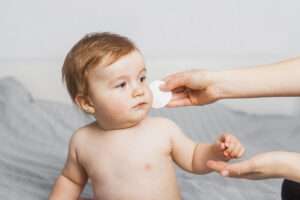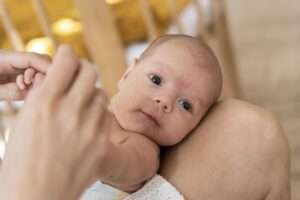Can Newborn Have Allergies? Causes, Symptoms, and Preventative Tips
- Dr Owais Rafiq
- November 22, 2024
- 5:02 pm

Can Newborns Have Allergies?
Of course, newborns experience allergies as well. Just as adults experience allergic responses, newborns and infants have the capacity to. Allergies within the coursework of young children occur because the child has an immune system that identifies a specific substance or rather a threat and goes ahead to fight the very substance. An allergy-causing substance is referred to as an allergen. This explainer seeks to cover the various allergies such as milk allergy, other food allergies, allergies to pollen in babies and toddlers, and the role of a pediatrician in managing such allergies in them.

Causes of Allergies in Newborns
It is not known why some babies have certain allergies while other babies do not. Another thing is family history, so if you carry a specific allergy, that baby may inherit yours or develop another one.
Genetics:
There is a family history of allergies. The risk of newborns increases with allergies in their family members. The risk of allergy increases if close family members have eczema. If asthma or hay fever is present in one family member, a baby has a 20-40% chance of developing an allergy. The risk increases to 60-80% when both parents or one parent and sibling have allergies. Some of these allergies will vanish as one grows up while most are lifetime.

Food and medicine
In the United States, the eight most common food allergens are:
- Milk
- Egg
- Peanut
- Tree nuts
- Soy
- Wheat
- Fish
- Shellfish
While some of these items may not be a concern for most babies, pay close attention when introducing foods such as milk (and milk products, like cheese), egg, and wheat to your baby.

Environmental
Common triggers of environmental allergies include:
- Pet dander, such as from a house cat or dog
- Mold
- Dust mites, which can be found in mattresses or bed linen
- Household cleaners
- Detergent
- Soaps and shampoos
Indoor Allergies
Your little one’s favorite stuffed animal could be an allergy trigger. Little specks of dust, called dust mites, make indoor allergies worse. And these mites collect in soft, cozy places like plush toys and pillows. Mold, cigarette smoke, and perfume also can trigger indoor allergies in kids.
You can assist your little angel in recovering by doing the following:
- Change and clean air duct filters one time per month.
- Do not carpet floors completely throughout the walls. It will accumulate dust.
- easy up the floors and surfaces and man or woman gadgets that can acquire dust frequently.
- For mattresses, container springs, and pillows, use allergen-proof zip-up covers.
- Wash all linens with warm water and placed them in a hot dryer each two to a few weeks.
Put your baby’s gentle toys in a sealed plastic bag and region it in a freezer for a minimum of five hours once every week. This kills dust mites.
- Do not use humidifiers and vaporizers. They upload moisture to the air and increase the threat of mold and dirt mites.
Seasonal Allergies
If symptoms worsen with specific seasons, then it may be hay fever, commonly called allergic rhinitis. This is one of the most common allergies have children and leads to sneezing and sniffling among other symptoms when some trees, grasses, and weeds flower. The most common allergy that children are exposed to is pollen from trees and plants.
The symptoms are the same one’s adults have:
- Runny, itchy nose
- Watery eyes
- Sneezing
- Stuffy nose
Your baby or toddler also may have ear pain. Both seasonal and indoor allergies can lead to chronic ear infections.
Symptoms of Allergies have Newborns
Recognizing the signs of an allergy early on can help you address it promptly. Keep an eye out for:
- Diffused and/or localized skin rashes (atopic dermatitis or eczema)
- Breathing difficulties (asthma)
- Out creeping, nasal drip, and eye discharge irritation – sneezing, coughing, and runny nose
- Stomach upset
- Shortness of breath, wheezing, or tightness in chest
- Trouble breathing or swallowing
- Swelling of the lips or tongue
- Tight throat, difficulty swallowing, hoarseness
- Weak pulse, symptoms of shock
- Vomiting, diarrhea (if severe or combined with other symptoms)
- Dizziness or fainting
- The Feeling of “doom,” confusion, drowsiness or agitation

The most common symptoms of a food allergy in babies and toddlers are:
- Belly pain
- Coughing
- Diarrhea
- Fainting
- Hives or rash
- Nausea or vomiting
- Red rash around the mouth
- Swelling of the face, legs, or arms
- Trouble breathing, including wheezing.
Preventative Tips for Newborn have Allergies
Allergic reactions are every so often lifelong situation that should be managed as opposed to cure, although many hypersensitive reaction symptoms in toddlers improve or go away as they grow old. You may tell what if any, allergic reactions your infant will have until they may be exposed to an allergen. And even as you may save your most allergic reactions, you can take steps to reduce the threat of allergies in the future.

Food and medicine
The key to food allergies is to introduce new foods slowly and independently. For example, the week you first give your baby an egg, don’t try any other new foods until you see how they react. If there are no signs of a food allergy or intolerance, then introduce another new food.
Breastfeed
Breast milk includes antibodies and omega-three fatty acids that would enhance your toddler’s immunity to hypersensitive reactions. consequently, experts advise breastfeeding for no less than six months and so long as the mom and toddler need to preserve.
Keep eating all foods if you are a breastfeeding mother
It is important to keep eating all foods if you are a breastfeeding mother. See an allergy trained doctor or dietitian before removing a food from your diet. Most allergic reactions do not occur through the breast milk.
Environmental
In case your infant has an excessive chance of developing hypersensitive reactions or allergies, decreasing your baby’s exposure early in existence to dirt mites may help save you from future allergic troubles and bronchial asthma. But there is now few evidence that early publicity to animals may assist reduce the risk of developing hypersensitive reactions to puppy dander. To assist reduce dirt mite exposure, use “allergen-impermeable” bedding and make sure to wash bedding in warm water. Also, regularly vacuuming and cleaning surfaces to avoid dust accumulation may help everyone in the house who might be sensitive.
Seasonal
If you’re concerned that your baby is allergic to pollen those blooms at certain times of the year or to other seasonal allergens, your best bet is to pay close attention to local weather reports and air quality alerts. On days when a particular pollen count is high, see if staying inside with the windows closed seems to help. The more you learn about seasonal allergens, the better you will be able to avoid exposure for your baby.
Dr Owais Rafiq
Subscribe to Dr Owais YouTube channel
For parenting advice, child health, symptoms, causes and treatment of illness in children.





